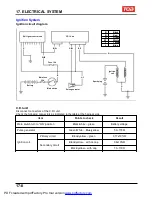
To this chapter contents
17. ELECTRICAL SYSTEM
Inspection on Charging Voltage
Voltmeter
Ammeter
Connect a tachometer.
Turn on the headlight to high beam and start the
engine.
Accelerate the engine to the specified revolution
per minute and measure the charging voltage.
Specified Charging Current:
1.2 A / 6000 rpm
Control Charging Voltage:
14.5 + 0.5 V / 2000 rpm
Fuse connector
Caution
To replace the old battery, use a new battery with
the same current and voltage.
Caution
●
Before conducting the inspection, be sure that
the battery is fully charged. If undercharged, the
current changes dramatically.
●
Use a fully charged battery having a voltage
larger than 13.0 V
●
While starting the engine, the starter motor
draws large amount of current from the
battery.
After the engine is warmed up, replace original
battery with a fully charged battery.
Connect a digital voltmeter to the battery
terminals.
Connect an ammeter between both ends of the
main fuse.
Caution
When the probe is reversibly connected, use a
voltmeter having an indication that the current
flows from the positive or the negative direction
and the measurement should be at zero,
ammeter at one direction only.
Caution
●
Does not use short-circuit cable.
●
It is possible to measure the current by
connecting an ammeter between the battery
positive terminal and the cable position
terminal, however, while the starter motor is
activated, the surge current the motor draws
from the battery may damage the ammeter.
Use the kick starter to start the engine.
●
The main switch shall be turned to OFF position
during the process of inspection. Never tamper
with the ammeter and the cable while there is
current flowing through. It may damage the
ammeter.
The following problems are related to the charging
system; follow the instructions provided in the
checking list to correct it if any one of the problems
takes place.
(1) The charging voltage can not exceed the
voltage between two battery terminals and
the charging current is in the discharging
direction.
(2) The charging voltage and current are too
much higher than the standard values.
The following problems are not related to the
charging system; correct it if any by following
steps indicate in the checking list.
(1) The standard charging voltage and current
can only reach when the revolution of the
engine exceeds the specified rpm.
-
Bulbs used exceed their rate and
consume too much power.
-
The replacement battery is aged and
does not have enough capacity.
(2) The charging voltage is normal, but the
current is not.
-
The replacement battery is aged and
does not have enough capacity.
-
Battery used does not have enough
electricity or is over charged.
-
The fuse of the ammeter is blown.
-
The ammeter is improperly connected.
(3) The charging current is normal, but the
voltage is not.
-
The fuse of the voltmeter is blown.
17-6
PDF created with pdfFactory Pro trial version
www.pdffactory.com
Содержание BLADE 250
Страница 1: ...BLADE 250 300 SERVICE MANUAL PDF created with pdfFactory Pro trial version www pdffactory com ...
Страница 145: ...13 BODY COVER Mechanism Diagram 13 1 13 PDF created with pdfFactory Pro trial version www pdffactory com ...
Страница 217: ...Home page Contents 18 ELECTRICAL DIAGRAM 18 18 1 PDF created with pdfFactory Pro trial version www pdffactory com ...
Страница 218: ...Home pae Contents 18 ELECTRICAL DIAGRAM Notes 18 2 PDF created with pdfFactory Pro trial version www pdffactory com ...
















































